The epic of Ramayana holds a special place in the cultural and spiritual fabric of Bharat (India) and beyond. Among its many versions and retellings, the Valmiki Maharshi’s Ramayana stands as the original and most authoritative text. However, even with such a revered source, numerous myths, misunderstandings, and controversies persist — particularly regarding the seventh book, the Uttara Kaand (or Uttara Ramayana). Is this final chapter a genuine part of the Ramayana, or is it a later addition, a myth, or a prakshit (interpolation)? This question has sparked passionate debates for centuries.
In this comprehensive exploration, we will delve deep into the Uttara Kaand, examining its background, structure, controversies, and authenticity. We will analyze arguments both supporting and questioning its validity, drawing from various ancient scriptures, manuscripts, and scholarly interpretations — all while maintaining an objective, atheistic standpoint to avoid devotional bias. Let’s embark on this journey to uncover the truth behind the Uttara Kaand.
Table of Contents
- Background and Context of Uttara Ramayana
- What is Uttara Ramayana?
- Structure and Storyline of the Ramayana and Uttara Ramayana
- Critical Analysis of Uttara Ramayana
- Conclusion: Is Uttara Ramayana Real or Myth?
- Why the Controversy Persists
- The Enduring Legacy of Ramayana and Dharma
- Frequently Asked Questions (FAQ)
- Final Thoughts
Background and Context of Uttara Ramayana
The Ramayana, as composed by Valmiki Maharshi, is the foundational text that most scholars consider the master version of this epic. Though there are hundreds of versions across different languages and regions—ranging from Tulasidas’s Ramcharitmanas in Awadhi to Kamban’s Ramavataram in Tamil, as well as versions in Southeast Asia—the original Sanskrit Ramayana by Valmiki remains the baseline for historical and textual analysis.
Popular culture, especially television serials and films, has propagated many myths about the Ramayana narrative that do not align with Valmiki’s original text. For example:
- Ahalya’s curse as a rock: Popular retellings depict Ahalya as turned into a stone and redeemed by Rama’s feet touching the rock. However, Valmiki’s Ramayana says Ahalya was invisible, like dust, and Rama touched her feet to redeem her, not the other way around.
- Ravana’s presence at Sita’s Swayamvar: Contrary to many depictions, Valmiki’s text does not mention a Swayamvar for Sita. Instead, it describes a detailed eight-chapter wedding ritual after Rama breaks the Shiva Dhanush (bow), and Sita was not even present at the moment of the bow breaking.
- Myths like Lakshman Rekha, Shabari tasting fruits, squirrels helping build the Rama Setu, and the Sita Agni Pariksha: None of these are present in the original Valmiki Ramayana. The so-called Agni Pariksha is actually an Agni Pravesha, where Sita attempts self-immolation upon hearing Rama’s harsh words, a crucial distinction.
These examples illustrate how popular narratives have often deviated from the original scripture. Similarly, the Uttara Ramayana is surrounded by myths and misconceptions, which we need to untangle with care.
What is Uttara Ramayana?
The Valmiki Ramayana traditionally consists of six books (kandas): Balakanda, Ayodhyakanda, Aranyakanda, Kishkindhakanda, Sundarakanda, and Yuddhakanda. These narrate the birth, exile, adventures, war, and coronation of Lord Rama.
Following these six is the Uttarakanda, sometimes called the seventh book, which deals with events after Rama’s coronation—his reign, family matters, and his final days. The key question is whether this Uttarakanda was authored by Valmiki Maharshi himself or is a later addition by unknown authors.
There are three main contentions fueling skepticism about Uttarakanda’s authenticity:
- Sita Parityaga: The episode where Rama abandons his pregnant wife Sita into the forest.
- Lakshmana’s Death: The narrative suggesting Rama’s involvement in Lakshmana’s demise.
- Rama killing Shambhuka: The episode where Rama kills a Sudra performing penance, which raises questions about caste and dharma.
These incidents are emotionally charged and challenge the idealized image of Rama as Maryada Purushottam (the perfect man). They have led many to reject Uttarakanda as a later interpolation or myth. But are these criticisms justified? Let’s examine the structure and storyline of the Uttara Ramayana for a clearer picture.

Structure and Storyline of the Ramayana and Uttara Ramayana
Here is a brief overview of the six canonical books of Valmiki’s Ramayana:
- Balakanda: Birth and childhood of Rama, his education, and marriage to Sita.
- Ayodhyakanda: Rama’s exile due to Kaikeyi’s wishes and the death of King Dasharatha.
- Aranyakanda: Life in the forest, encounters with demons, and Sita’s abduction by Ravana.
- Kishkindhakanda: Alliance with Sugriva and the search for Sita.
- Sundarakanda: Hanuman’s journey to Lanka, meeting Sita, and burning Lanka.
- Yuddhakanda: The battle between Rama and Ravana, the building of Rama Setu, and Rama’s victorious return and coronation.
Uttarakanda contains 111 chapters (sargas) and covers:
- Chapters 1–34: Detailed history and atrocities of Ravana, explaining his villainy beyond just abducting Sita.
- Chapters 35–36: Birth and childhood of Hanuman.
- Chapters 37–41: Early events in Rama’s reign.
- Chapters 42–52: Conception of Sita’s children and the controversial Sita Parityaga episode.
- Chapters 53–72: Shatrughna’s killing of the demon Lavadasura.
- Chapters 73–83: The killing of Shambhuka, the Sudra ascetic.
- Chapters 84–94: The Ashwamedha Yagna performed by Rama.
- Chapters 95–99: Rama’s reunion with his sons Lava and Kusha and the end of Sita’s life.
- Chapters 100–102: Coronation of the next generation kings, including references to kingdoms in modern-day Pakistan and Afghanistan.
- Chapters 103–111: The final days and departure of Rama and his brothers.
This extensive content shows that Uttarakanda is not merely an addendum but a detailed continuation of the Ramayana narrative. But the question remains: who authored this text?
Critical Analysis of Uttara Ramayana
Approaching this question requires a methodical and unbiased analysis. Here, we present ten key points to understand the authenticity of the Uttara Ramayana, with arguments and counterarguments based on undisputed facts and textual evidence.
1. The Name of the Epic
Valmiki Maharshi, in his own Ramayana, refers to the epic by three names:
- Ramayanam: The journey of Rama.
- Sita Charitam: The history of Sita.
- Paulasya Vadha: The killing of Paulasya (another name for Ravana).
The title Paulasya Vadha suggests the epic ends with Ravana’s death. This would imply no need for a continuation like Uttarakanda.
Counterargument: The Uttarakanda dedicates about 30% of its chapters to Ravana’s history and atrocities, explaining why his killing was justified. This adds depth to the title Paulasya Vadha. Furthermore, the title Sita Charitam implies the story of Sita’s life continues beyond the six kandas, covering her queenship, motherhood, and end—all detailed in Uttarakanda.
Hence, Uttarakanda complements the epic’s titles and is logically consistent with Valmiki’s narrative goals.
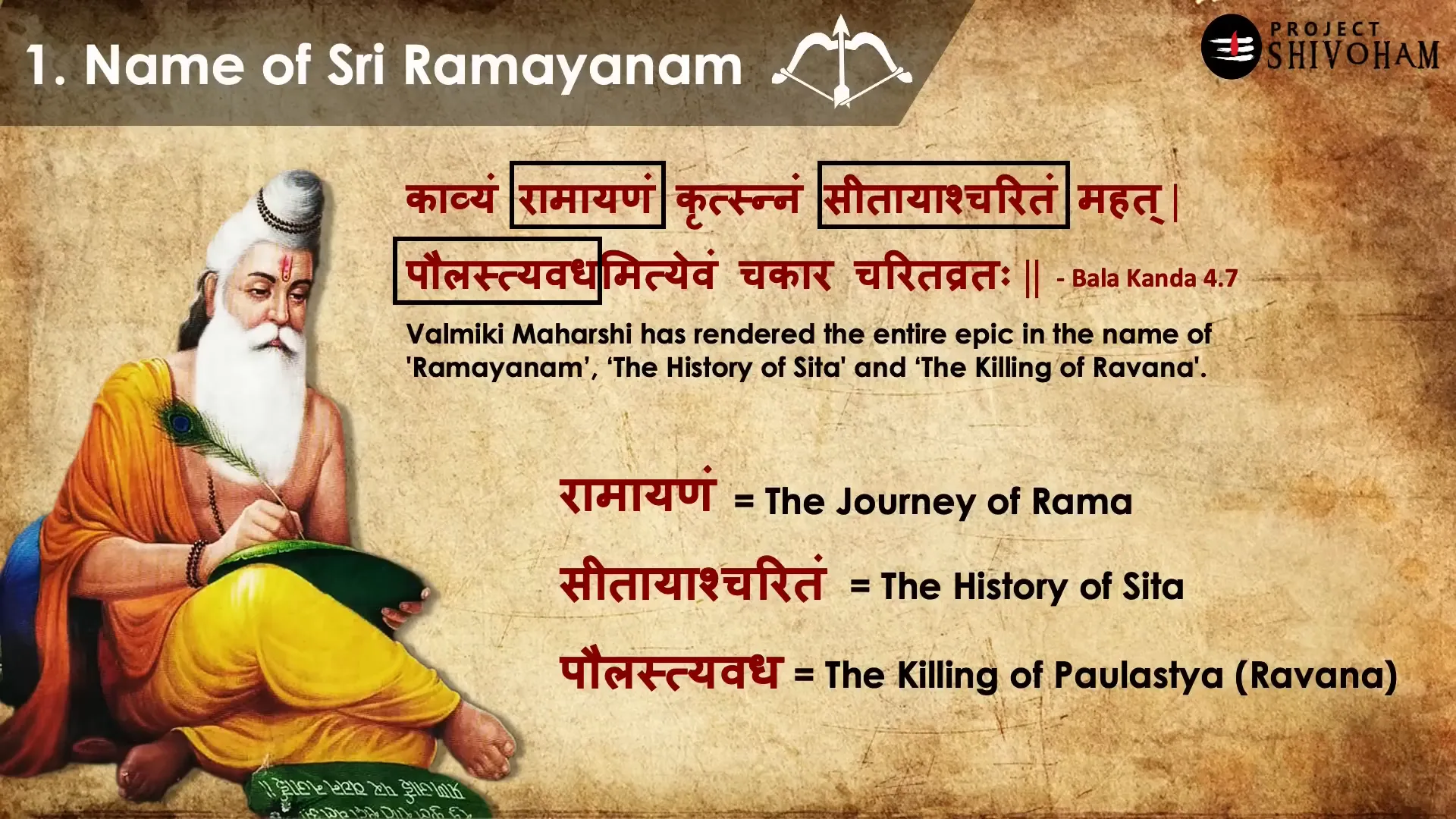
2. Writing Style and Structure
The first chapter of Balakanda contains the Sankshipta Ramayana, a summary of the entire Ramayana in 100 slokas. This summary ends with Rama’s coronation, matching the end of Yuddhakanda. This seems to suggest there is no Uttarakanda.
Counterargument: The Sankshipta Ramayana condenses the entire war in just one sloka but elaborates it into a full kand named Yuddhakanda. Similarly, seven slokas describing Rama’s reign could have been expanded into Uttarakanda. This indicates Uttarakanda could be an authentic continuation, consistent with Valmiki’s writing style.

3. References in Mahabharata
Mahabharata, the other great Indian epic, narrates the Ramayana twice: once by Hanuman to Bhima, and once by Markandeya Maharshi to Yudhishthira. Both narrations end with Rama’s coronation, without mention of Uttarakanda.
Counterargument: Markandeya Maharshi’s narration begins with a prologue on Ravana’s atrocities—details that correspond with Uttarakanda and are absent in the six kandas. Thus, Mahabharata contains references to Uttarakanda, suggesting its authenticity.

4. Padma Purana’s Account
The Padma Purana, attributed to Vedavyasa Maharshi, is divided into seven khandas, including an Uttarakhanda. It details Uttara Ramayana extensively in its Pathalakanda, spanning 68 chapters. If Uttarakanda were a myth, Padma Purana’s lengthy coverage would be questionable.
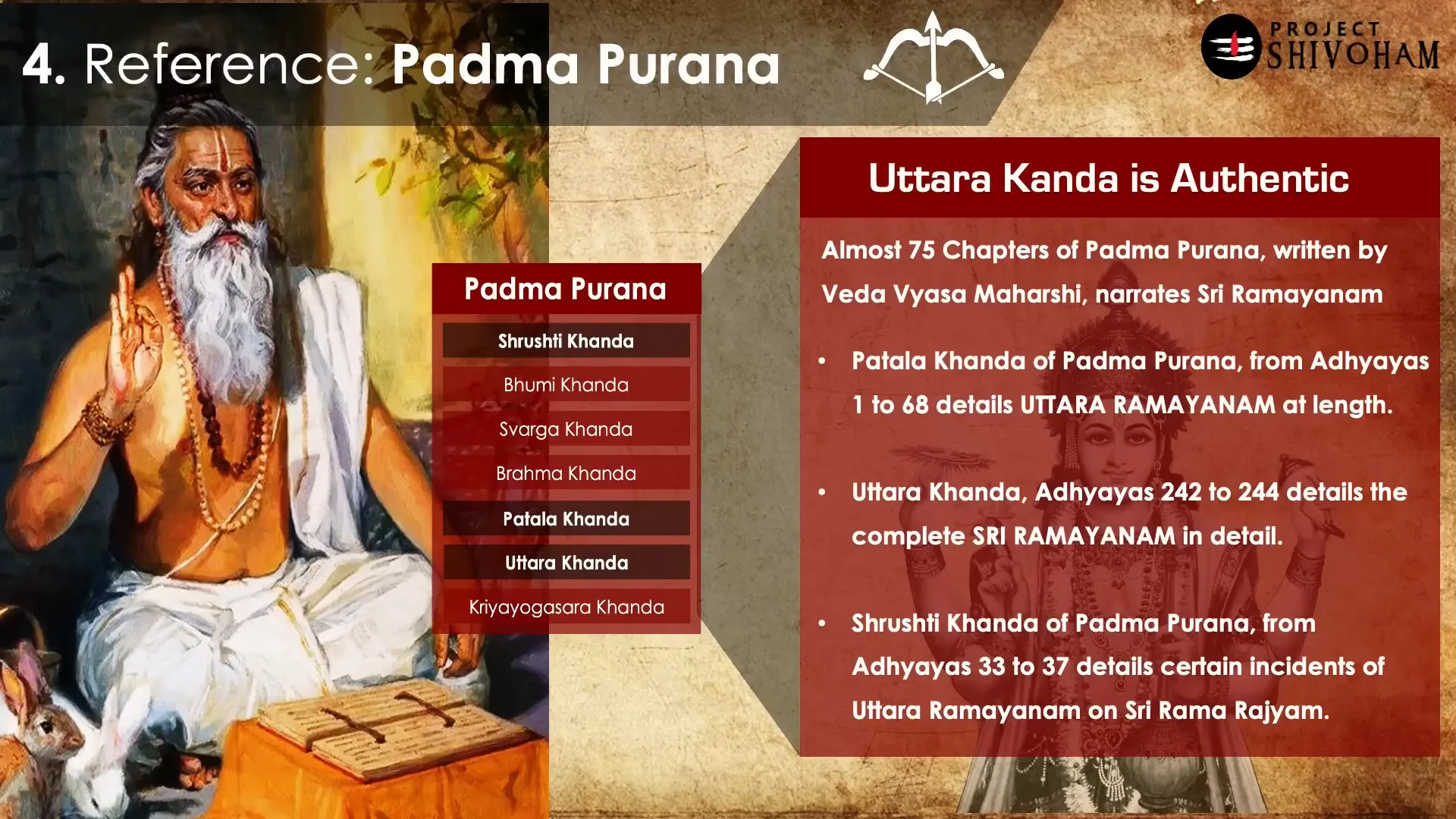
5. Skanda Purana’s Testimony
Skanda Purana, the longest among the eighteen Puranas, includes the Vaishnavakhanda with the Ayodhya Mahatmya section. This section references both the six kandas and the Uttarakanda of Ramayana. Notably, Skanda Purana was cited in the landmark Ram Janmabhoomi Supreme Court judgment, establishing its authoritative value.

6. Temple Carvings and Iconography
Many ancient temples feature carvings depicting Ramayana scenes, such as Ellora’s Kailash temple, which portrays the epic up to Rama killing Ravana and becoming king. However, depictions of Uttarakanda episodes are rare or absent. This absence suggests Uttarakanda may have been a later addition or less emphasized historically.

7. British Archives of Manuscripts
During British colonial rule, many ancient Indian manuscripts were collected and cataloged. A 1902 catalog notes palm leaf manuscripts of Valmiki’s Ramayana containing only six kandas, with no Uttarakanda. This supports the theory that Uttarakanda was a later interpolation.
Counterargument: The same catalog also lists a separate palm leaf manuscript of Uttara Ramayana attributed to Valmiki Maharshi. This indicates the existence of an independently preserved Uttarakanda text, complicating the authenticity debate.
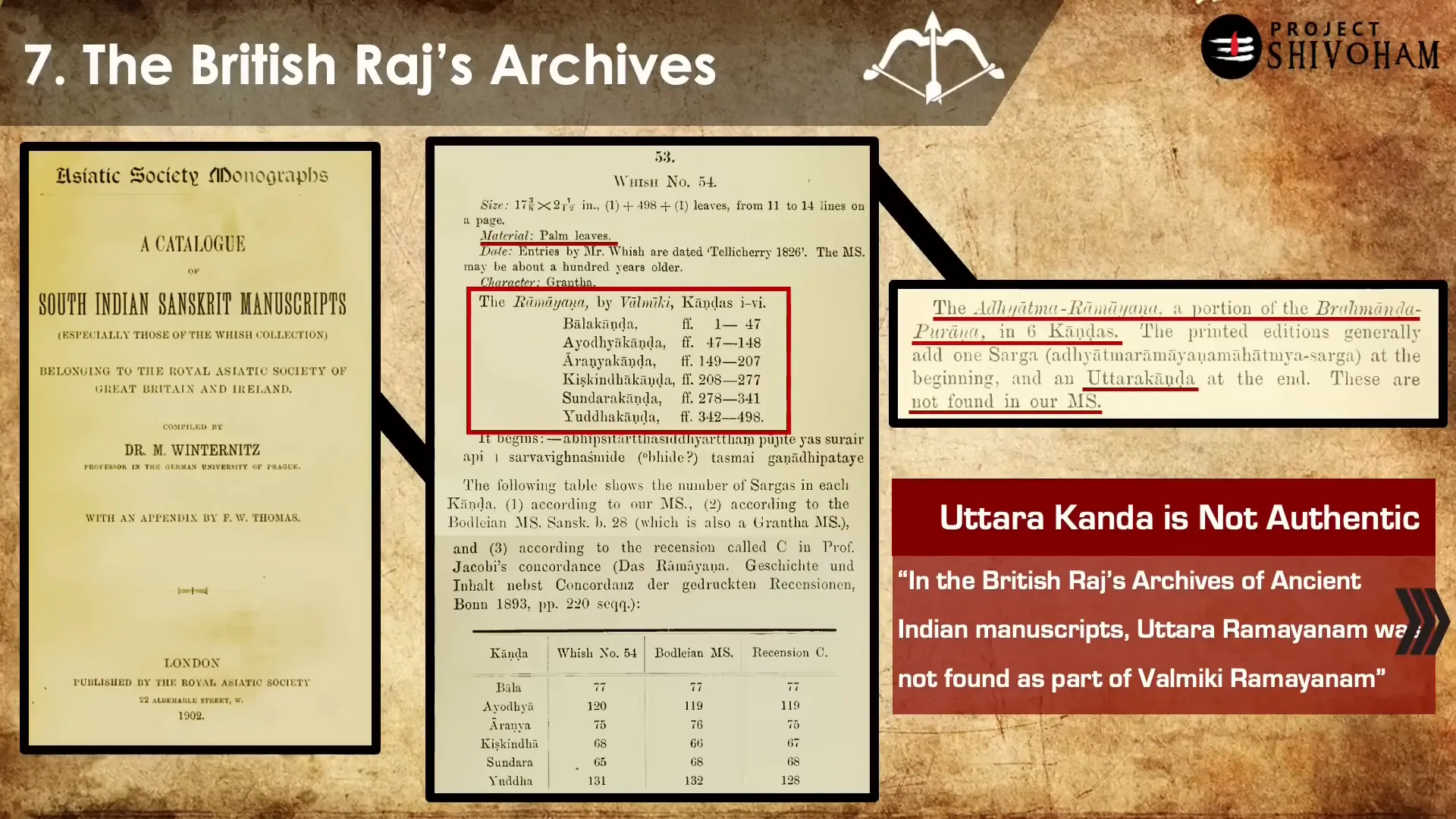
8. Absence in Popular Retellings
Two of the most respected retellings, Ramcharitmanas by Tulsidas and Ramavataram by Kamban, do not include Uttarakanda. While Ramcharitmanas has a section called Uttarakanda, its contents differ significantly from Valmiki’s purported seventh book, suggesting it is a distinct work.
This absence in influential versions suggests Uttarakanda’s authenticity is questionable.
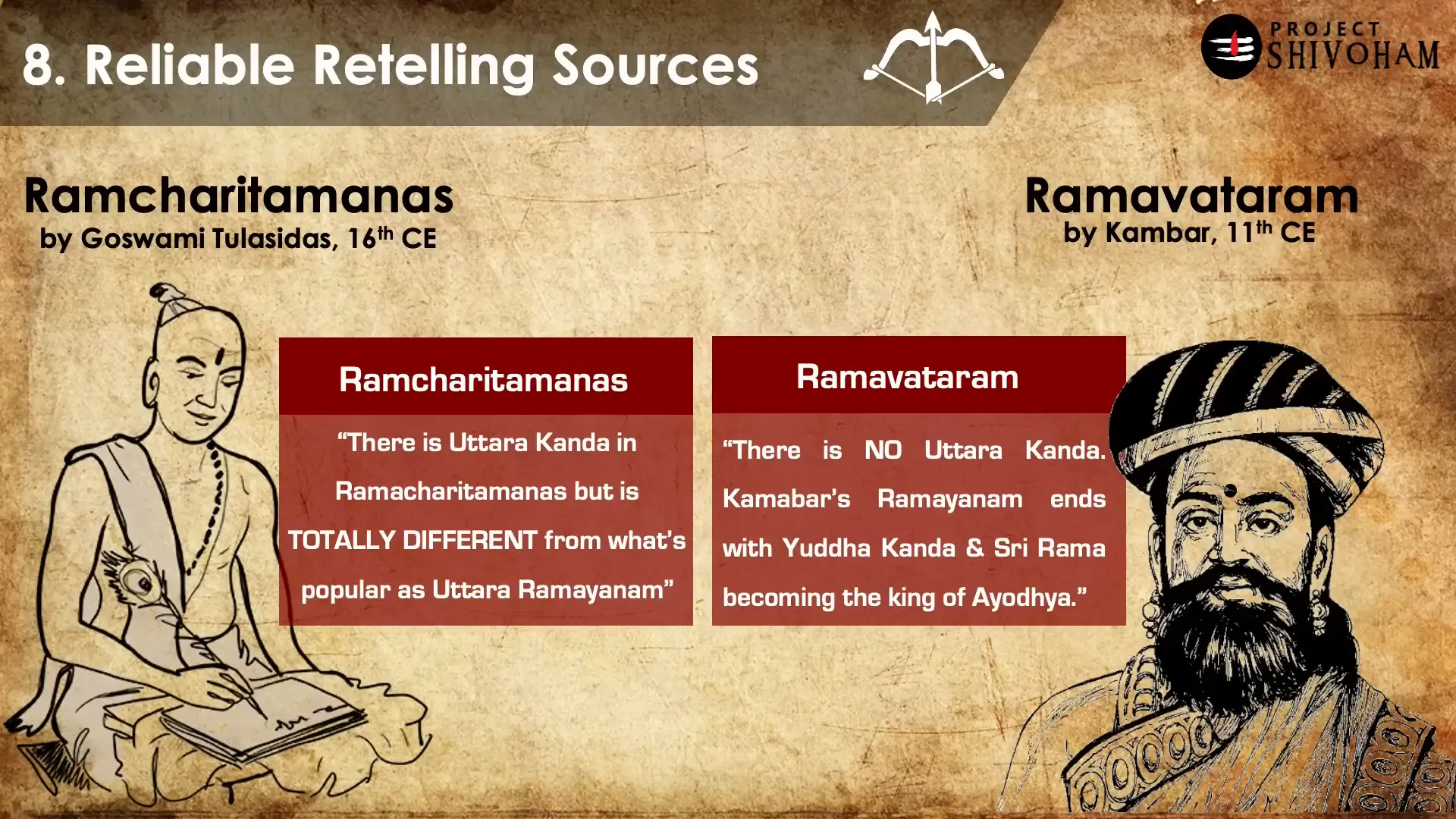
9. Naming Convention
Each of the six kandas is named after its central subject or location: Balakanda (childhood), Ayodhyakanda (Ayodhya), Aranyakanda (forest), Kishkindhakanda (Kishkindha), Sundarakanda (beauty, Lanka), and Yuddhakanda (war). The word “Uttara” means “next” or “later,” which stands out as vague and inconsistent with the naming pattern.
One might expect a name like “Rama Rajya Kanda” to reflect Rama’s reign. The odd naming raises questions about whether Uttarakanda was named or authored by Valmiki Maharshi.
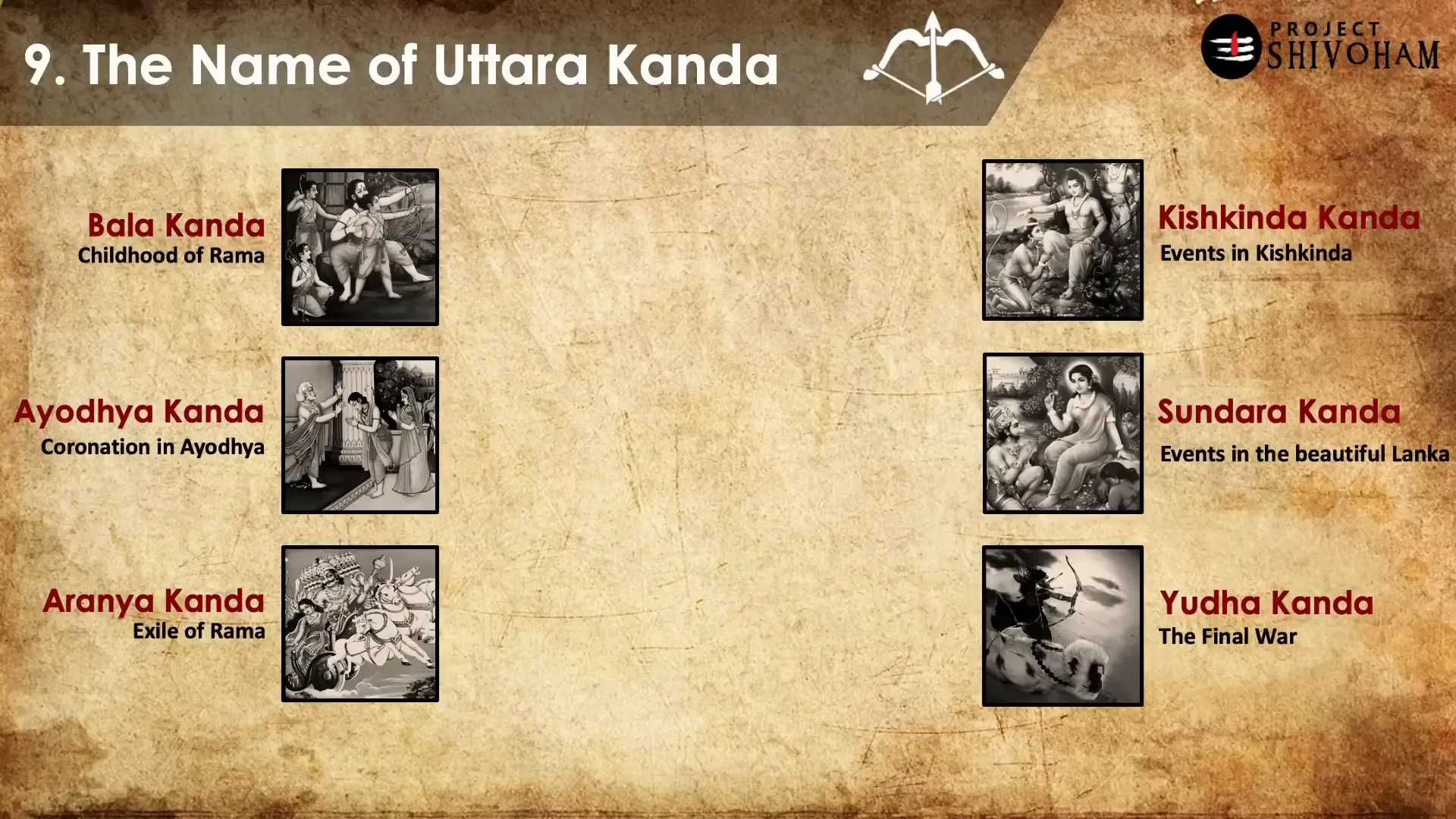
10. The Big Open Secret: Valmiki’s Own Words
Perhaps the most decisive point is a sloka from Balakanda, the fourth sarga, second verse, where Valmiki Maharshi himself states:
“Valmiki composed the Ramayana in 24,000 shlokas, 500 sargas, across six kandas, followed by an Uttara Kanda.”
This explicit mention confirms the existence of an Uttara Kanda as part of the original Ramayana composition. This revelation challenges the skepticism and asserts that Uttarakanda was indeed authored by Valmiki Maharshi.

Conclusion: Is Uttara Ramayana Real or Myth?
After analyzing these ten points, it becomes clear that Uttara Ramayana is not a myth but a real and integral part of Valmiki’s Ramayana. The textual evidence, references in Mahabharata, Padma Purana, Skanda Purana, and Valmiki’s own words affirm its authenticity.
However, the reason Uttarakanda is often viewed with suspicion is due to its sensitive and emotionally complex content, including:
- Rama’s abandonment of pregnant Sita (Sita Parityaga).
- Rama’s indirect role in Lakshmana’s death.
- Rama killing Shambhuka, a Sudra performing penance.
- Killing of Vali in stealth.
- Sita’s Agni Pravesha (self-immolation attempt), often confused with Agni Pariksha.
These episodes challenge the idealized image of Rama and require nuanced understanding beyond surface judgments.
Understanding the Controversial Incidents
Killing of Vali
Rama killed Vali stealthily because Vali had committed many atrocities, including against his own brother Sugriva. Rama compared this act to hunting an animal (Mrugayam Dharma), which is acceptable for a king. Rama explained and justified his actions in Kishkindha Kanda (chapters 16–18).
Sita’s Agni Pravesha
After Ravana’s defeat, Rama’s harsh words to Sita were driven by concern for public opinion (Janawada Bhayat). Sita’s self-immolation was a response to these painful words, not a test by fire (Agni Pariksha). This distinction is critical.
Sita Parityaga (Abandonment)
People in Ayodhya questioned Rama’s personal life with Sita due to her abduction by Ravana, using harsh and disrespectful language. Rama prioritized his duty as a king (Raja Dharma) over personal feelings, leading to Sita’s abandonment.
Lakshmana’s Death
A sage requested a private conversation with Rama, vowing that anyone who interrupted should be killed. Lakshmana inadvertently entered, forcing Rama to uphold his word. Lakshmana then voluntarily left and died, with Rama indirectly responsible.
Killing of Shambhuka
Shambhuka, a Sudra, performed penance forbidden in Treta Yuga by the social dharma of that era. Rama killed him to uphold dharma. Notably, a sloka in Uttarakanda clarifies that in Kali Yuga (our time), Sudras can perform penance, highlighting the time-bound nature of social rules.
Dr. B. R. Ambedkar’s book Annihilation of Caste explains the socio-economic governance system (Chaturvarna) and advises against judging ancient practices by modern standards.
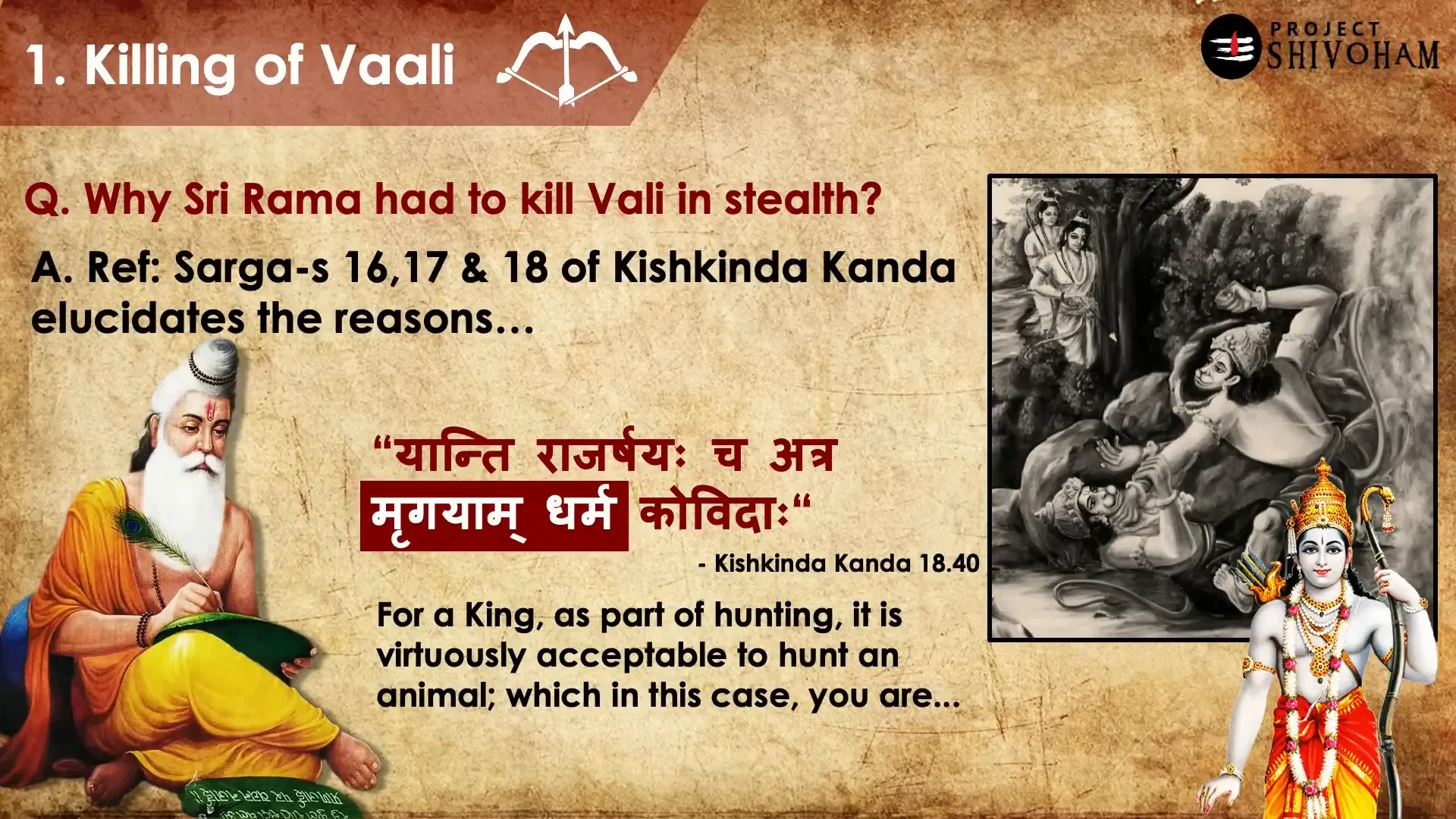
Why the Controversy Persists
Despite clear textual references, Uttarakanda remains controversial because:
- Its content challenges the idealized, devotional image of Rama.
- It is often found separate from the six kandas in manuscripts and temple carvings.
- It is omitted from popular retellings and translations.
- Its naming convention differs from the other kandas.
This leads to debates about its authenticity and rightful place in the Ramayana corpus. However, a reasonable reconstruction of Uttarakanda can be formed by synthesizing information from Padma Purana, Skanda Purana, and Mahabharata, providing a holistic view of Rama’s life and reign.
The Enduring Legacy of Ramayana and Dharma
Stepping beyond textual debates, the Ramayana’s enduring popularity across Bharat and the world is rooted in its message of dharma—righteousness, duty, and moral responsibility. Rama and Sita’s lives exemplify unwavering commitment to dharma, even amidst extreme personal suffering. This message resonates deeply, shaping the cultural and ethical ethos of India for millennia.
It is impossible to find a town or village in Bharat without a Ramalayam (temple dedicated to Rama), reflecting the epic’s profound impact. The Ramayana continues to be a cultural backbone, inspiring devotion, literature, art, and moral values.
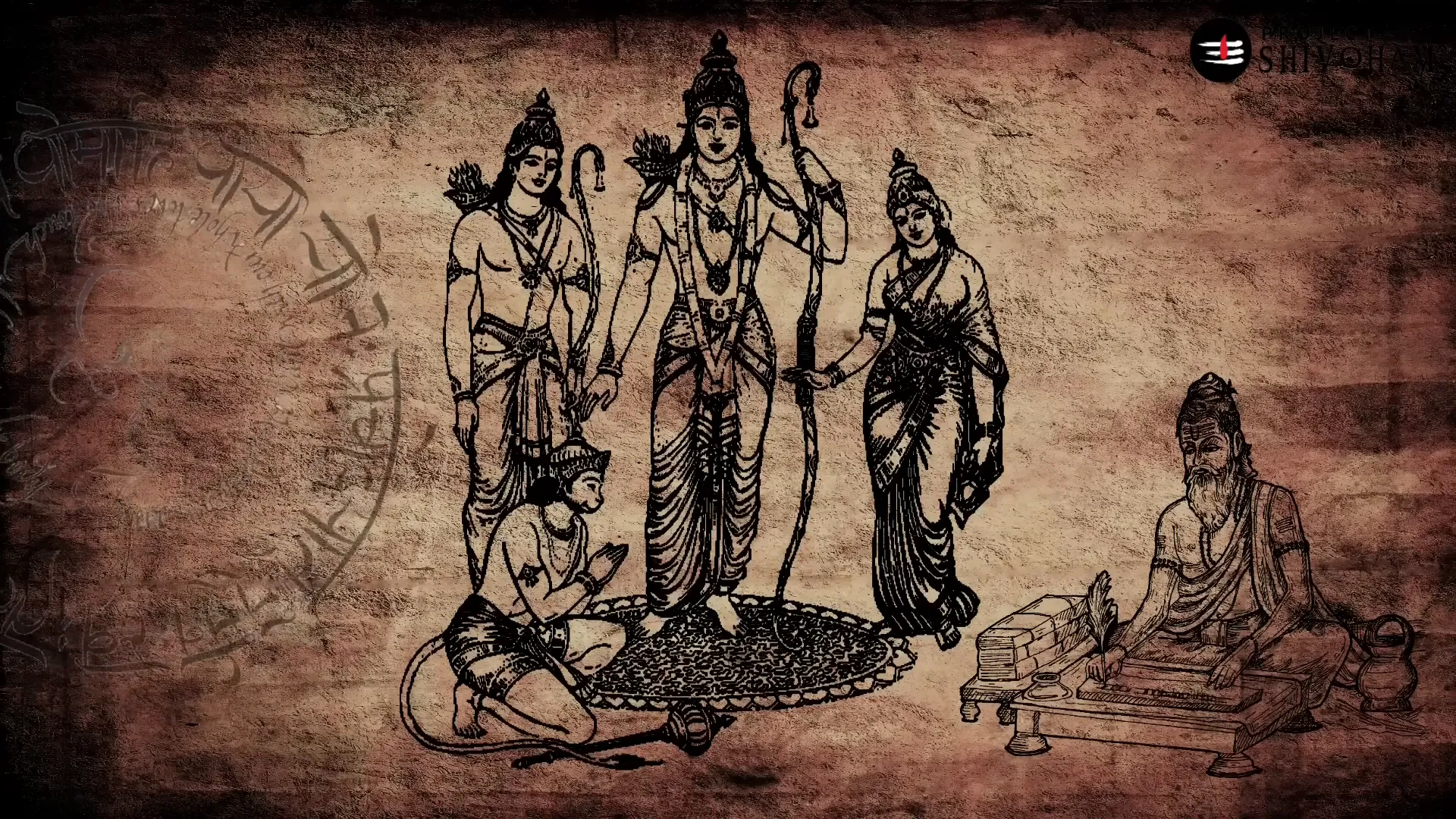
Frequently Asked Questions (FAQ)
Is Uttara Ramayana part of Valmiki’s original Ramayana?
Yes, textual evidence including Valmiki’s own words in Balakanda confirms that Uttarakanda was authored by Valmiki Maharshi as a continuation of the six kandas.
Why is Uttara Ramayana controversial?
Because it contains emotionally challenging episodes like Rama abandoning Sita, Lakshmana’s death, and Rama killing Shambhuka, which conflict with the idealized image of Rama and raise questions about dharma and social norms.
Are the myths like Lakshman Rekha and Sita Agni Pariksha in Valmiki’s Ramayana?
No, these are later additions popularized by folklore, television, and cinema. Valmiki’s original Ramayana describes different versions, such as Sita’s Agni Pravesha (self-immolation attempt), not the Agni Pariksha.
Why is Uttarakanda often found separate from the six kandas?
Historically, manuscripts and temple carvings often excluded Uttarakanda, possibly due to its controversial content, leading to its separate preservation and lesser emphasis.
How should one approach the controversial incidents in Uttarakanda?
With an open mind and understanding of the historical and social context of the time. Reading the original Sanskrit verses and scholarly translations helps grasp the nuanced meanings beyond popular interpretations.
What is the significance of Uttarakanda in the broader Ramayana narrative?
It completes the story of Rama and Sita, detailing Rama’s reign, Sita’s motherhood, and their final days, thus providing a full picture of their lives and fulfilling the epic’s titles like Sita Charitam and Paulasya Vadha.
Can Uttarakanda be reconciled with modern values?
While some episodes reflect ancient social structures like the Chaturvarna system, scholars like Dr. B. R. Ambedkar advise understanding these within their historical context rather than judging them by modern standards.
Final Thoughts
The Uttara Ramayana is neither a myth nor a mere interpolation. It is an authentic and integral part of Valmiki Maharshi’s Ramayana, rich with complex narratives that challenge simplistic views. Its content demands careful reading, contextual understanding, and scholarly inquiry.
By embracing the full Ramayana—including Uttarakanda—we gain a deeper appreciation of dharma, human complexity, and the timeless lessons embedded in this ancient epic.
Jai Shri Ram!
This article was created from the video The Controversy of UTTARA KAAND – Myth or Real? with the help of AI. Thanks to Aravind Markandeya, Project Shivoham.